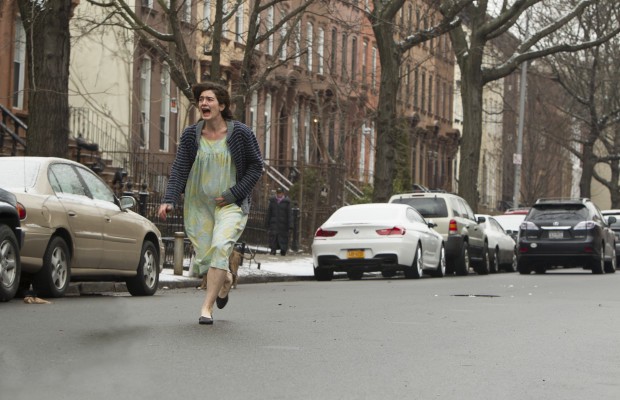People are always telling me they don’t like horror. Like right
after I tell them I make horror films. Or programmers picking
me up from the airport who have barely said hello and whose festival I’m playing my film at. And I used to get it. People think of horror as all sadism, gore and
naked-ish women running away from saws. But recently, I’ve been bridling at how
so many people can write off an entire genre. Not to mention the casual
criticism of something I love and work hard at making.
So I thought I would explain why horror is
important for the world.
I’ll start with my own work. “Lyle” is my first feature and is
coming out on VOD this month. It’s a take on “Rosemary’s Baby,” but with
lesbians. Gaby Hoffmann plays Leah, a
grieving mother, and Ingrid Jungermann, who was my girlfriend at the time,
plays her partner. The terror of the
story comes straight out of Leah’s bereavement and all that magical thinking
that so easily fits into the altered space of death and horror. It’s a personal story — a kind of break-up
film — like a really severe break-up film — that exaggerates feelings and ideas that were gnawing at me. And this is
what I think good horror can do: It can test a concept or issue to the limits
and investigate the darkest version of it. The exaggeration of horror can be
clarifying. “Lyle” examines a woman living a lie. Her relationship, life goals
and domestic situation require a mounting denial that eventually erupts. It has all the elements of a good drama — I
just drag Satan into it.
Horror is also endlessly appealing for its cinematic
possibilities. There is usually a parallel world or space where you can
visually depart from reality. This is exhilarating creatively. I’m thinking of
some of my favorite films: “The Shining,” “The Innocents,” “Cat People.” I also argue it’s the most sensual genre there is.
Every sound, shadow and look is organized to pull you into an empathetic
trance. In fact, “Lyle” was originally shot as a 10-part web series, but I quickly
realized that watching it in pieces broke that sensual spell. It was like stopping sex in the middle and picking up where you left off later. It just
didn’t work.
Most importantly, horror can reflect the
fears and trends of a particular time. Good horror is relevant and cathartic.
For all the people who detest horror, there sure are a lot of viewers craving zombie and vampire stories these days. We shuffle around monsters and genres to analyze
contemporary issues and our cultural climate. Vampires often tackle or endorse
sexual repression. Zombies stand in for unstable times — what to do if your
world falls apart and how to rebuild and take on big issues like society building
and racism. And every once in a long while, we get a new monster who manages to
stick around, like the Internet-created Slender Man, whose terrifyingly ambiguous
motivations and lack of rules are reminiscent of global terrorism.
It’s also about time that more women make horror films. Films
like Ana Lily Amirpour’s “A Girl Walks Home Alone at Night” and Jennifer Kent’s “The Babadook” are shaking up the brand and
proving that horror isn’t just blood and cheap thrills. I’m currently
developing a script about witches and trying to understand what they
mean and why there are so few good witch movies. My hunch is it has something
to do with being one of the only female-based monsters. But I have found a few
wonderfully strange witch movies like “Burn Witch Burn” from 1962. It’s a
feminist story that pits science against intuition and revolves around a
stay-at-home wife who isn’t taken seriously by her husband. (It also begins
with a warning that the film is cursed.)
All this is to say that we need horror. Horror lets us take a
frank look at the stuff that scares us and either work through it or expose
it. As a child, I longed for the dark
stuff. I wanted black-and-white melodramas and twilight zones over Sesame
Street and cartoons. I found comfort in facing the darker stuff, and I think
many others do too. It’s time to see the
whole potential of this genre and not reduce it to its torture-porn reputation.
https://content.jwplatform.com/videos/f4Uos8vi-720.mp4
Stewart Thorndike’s first feature film “Lyle” premiered to critical praise at Outfest 2014, where star Gaby Hoffmann received the Grand Jury Prize for Best Actress. (It was released on VOD and DVD on September 29. The DVD also includes Thorndike’s latest short film.) “Putney” is her second female-driven psychological horror film. She is from Tacoma, Washington, and earned an MFA from the NYU Graduate Film Program. Thorndike is currently a fellow with the San Francisco Film Society’s inaugural Women Filmmaker Fellowship.







